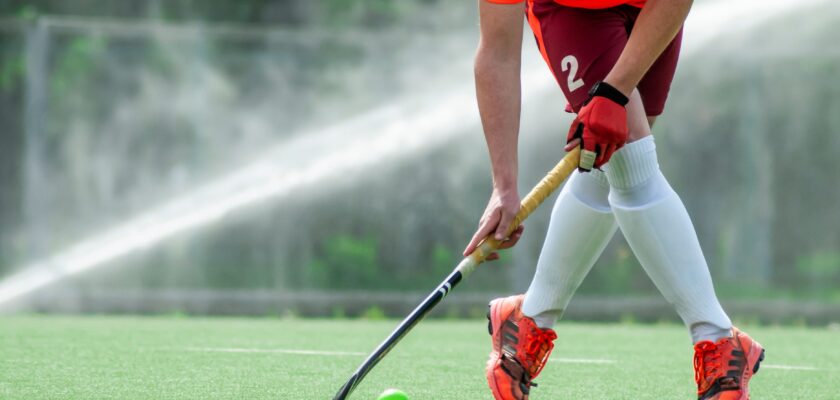Field hockey on grass derives its name from the French word “hocquet”, which means shepherd’s staff, alluding to the curvature of the stick, and its origins date back to antiquity. You may already know about ice hockey, but today you’re going to learn all about field hockey!
Open your Betano account and get up to 1,000 reais in bonuses.
Payments via PIX, live games and super odds!
Click here to open your account!

Read to the end and learn all about field hockey!
All about Field Hockey: history
The practice of using a bat to propel a ball is not new. Evidence suggests that the Egyptians and Ethiopians were already involved in this activity millennia ago, as were the Greeks, Romans and Aztecs in later times.
However, the form we know as field hockey on grass began to develop in the 18th century in England.
After the creation of the first clubs dedicated to the sport, the first rules were established in 1875.
Read to the end and learn all about field hockey!
The first international grass field hockey match between universities took place in 1890 between Oxford and Cambridge.
A crucial change in the rules of field hockey took place in 1886 with the introduction of the pitching area, known as the “striking circle” in English.
This semicircle, located at a maximum distance of 14.63 meters from the end line, defines the zone where goals can be scored.
With this change, the game became more tactical and technical, as the players had to make more passes before attempting a goal.
Another important milestone in the history of hockey on grass was its introduction in India and Pakistan, thanks to British influence.
The sport quickly consolidated itself in these countries, bringing great achievements. Of Pakistan’s 12 Olympic medals, ten were in grass field hockey, including 4 gold.
Read to the end and learn all about field hockey!
India has an even richer record, with 9 gold medals, 1 silver and 2 bronze.
Grass field hockey made its Olympic debut in London in 1908. Since then, only the Games in Stockholm in 1912 and Paris in 1924 have not included the sport.
Until Montreal in 1976, grass field hockey was played exclusively in the men’s category, with women starting to compete for medals in Moscow in 1980.
Read to the end and learn all about field hockey!
Grass field hockey made its debut at the 1908 Olympic Games in London, before becoming a permanent fixture on the Olympic program from the 1928 Games onwards (with the exception of the 1912 and 1924 Games, although it was included in the 1920 Games in Antwerp). The women’s category was added to the Olympic Games in Moscow in 1980.
Due to its contemporary Anglo-Saxon roots, modern grass field hockey has been largely dominated by countries that are or were members of the British Community, such as India, Pakistan, Australia, New Zealand, South Africa and, of course, Great Britain.
India and the Netherlands stood out significantly in the men’s and women’s competitions respectively.
India won eight gold medals, including six in a row between 1928 and 1956, during which time they scored 197 goals and conceded just eight.
The Netherlands have won a total of 9 medals, including 4 gold, most recently at the Tokyo 2020 Olympic Games.
Read to the end and learn all about field hockey!
However, other countries such as Argentina, Germany, Spain, France and the current men’s Olympic champion, Belgium, have also reached the top of the international rankings, making the sport truly global.
All about grass field hockey: main rules
These are just some of the fundamental rules of grass field hockey. The sport has a more detailed set of rules that regulate every aspect of the game, from the conduct of the players to the dimensions of the pitch and the equipment!
Duration of the match
A match is divided into four halves of 15 minutes each, with breaks between periods. In official competitions, there may be extra time and, if necessary, penalty kicks to determine the winner.
Read to the end and learn all about field hockey!
Equipment
- Ball: the ball is made of cork and plastic, 23 cm in circumference and weighing around 160 grams.
- Cue: cues are usually made of carbon fiber or fiberglass and should weigh between 350 and 700 grams.
Teams
Each team consists of 11 players, including the goalkeeper.
Goals
The aim is to score goals, which are validated when the ball crosses the goal line between the posts, which are 2.14 meters high and 3.66 meters wide.
Goalkeepers
Goalkeepers are the only players who can use any part of their body to touch the ball. They must wear special protective equipment for their head, torso, legs and arms.
Throwing area
Also known as a striking circle, it is a semi-circular area with a radius of 14.63 meters around the goal. Only players inside this area can score directly.
Fouls and penalties
Fouls can occur when a player intentionally impedes an opponent’s progress or commits infractions such as pushing, holding or throwing the ball with their feet. Penalties can include the penalty corner and the penalty stroke.
Penalty Corner
When a foul is committed inside the pitch, the attacking team can be awarded a penalty corner, where the ball is placed on a line and the team has a chance to attack the goal.
Read to the end and learn all about field hockey!
Penalty Stroke
It is awarded when a foul occurs inside the shooting area that prevents a clear chance of scoring. A player has a direct shot on goal, with only the goalkeeper in front.
Player changes
Teams can make substitutions during the game, but substitutions are usually made in designated areas at the side of the pitch.
Main techniques
- Flick: consists of carrying the ball through the air with the bat. It’s a complex move, but it’s often used to dribble past opponents.
- Push-hit: the ball is pushed by the player. It is widely used both to score goals and to make passes.
- Obstruction: the player uses their club or body to block the ball, creating an obstruction. This action is classified as a foul.
Read to the end and learn all about field hockey!
All about grass field hockey: curiosities
- Charles Miller, known as the “father” of Brazilian soccer, also played grass field hockey in England. Some scholars consider him to be one of the first to introduce the sport to Brazil;
- Field hockey on grass was brought to Brazil at the end of the 19th century by Englishmen on business;
- India has won more than half of the gold medals available in the history of the Olympic tournaments;
- One of the greats of grass field hockey is India’s Balbir Singh, who was part of the team that won gold medals at the London 1948, Helsinki 1952 and Melbourne 1956 Olympic Games;
- In 2012, Brazil took part in an FIH competition for the first time, the London Pre-Olympics, held in Kakamigahara, Japan;
- The matches are played on grass or synthetic material pitches with dimensions of 91 meters long by 55 meters wide, divided into two halves of 35 minutes each;
- Players use sticks, usually made of wood, weighing between 350 grams and 700 grams and with a maximum diameter of 5 centimetres;
- The ball, made of plastic and cork, weighs approximately 160 grams and has a diameter of 3 centimeters;
- The goalposts have dimensions of 3.66 meters wide by 2.10 meters high, and around them there is a demarcated area – a semicircle at a maximum distance of 14.63 meters from the end line;
- The goal is only valid if it is scored inside this area, known as the striking circle;
- Players may not raise the stick above their shoulders or use their hands or feet to control the ball.
Did you enjoy learning all about field hockey? Check out other exciting sports like:



